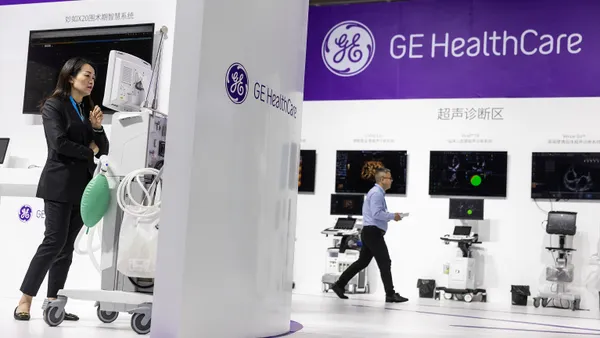Dive Brief:
- Johnson & Johnson on Tuesday said worldwide sales in its medical device unit declined 0.2% in the third quarter to $6.6 billion, as a negative currency impact of 1.9% outweighed an operational increase of 1.7%.
- Excluding acquisitions and divestitures, worldwide medical device sales increased 2.9% on an operational basis, with domestic sales up 1.2% and international sales growing 4.4%. In the spine area, the company divested its Codman neuroscience business.
- J&J Chief Financial Officer Joseph Wolk told analysts on the conference call that the company is not satisfied with the performance of the medical device business but is seeing improvements. “The third quarter is a positive step toward our goal of returning to above-market growth in 2020,” Wolk said.
Dive Insight:
J&J's medical device business has been a chronic underperformer for the company and is the focus of a turnaround effort. Last year, the healthcare giant invested roughly $1 billion to bolster its device offerings through about 30 tuck-in acquisitions.
Medical device sales accelerated in the third quarter compared with the first half of the year, and company officials, speaking on a conference call with analysts, said they expect the momentum to continue.
Across the company's medical device segments, worldwide sales climbed 18.1% to $653 million in interventional solutions, grew 3.8% to $1.13 billion in the vision business, and rose 1.3 percent in surgery to $2.37 billion in surgery. Sales declined 4.2 percent to $2.11 billion in orthopedics and fell 22.2% to $315 million in diabetes.
Half of the medtech platforms are growing at rates that are above market averages, said Ashley McEvoy, worldwide chairman of J&J's medical devices business. “Clearly we are very focused on flipping platforms that have been underperforming,” she said, while working to accelerate momentum in faster-growing areas.
She noted the company is launching between 15 and 20 new device products this year. Acknowledging the growing impact of robotics on the surgical device market, McAvoy also said she anticipates the company will have a competitive offering in that area in the foreseeable future.
To speed the turnaround in underperforming device businesses, J&J continues to look at potential acquisitions, whether large or tuck-in, across all medtech categories, the executives said.
In the third quarter, the medical device unit was bolstered by growth in sales of electrophysiology products, Acuvue contact lenses, endocutters and biosurgical instruments in the advanced surgery business, and wound closure products in the general surgery business.
J&J executives also addressed hospital admissions trends, noting the third quarter saw a modest decline in the growth rate to 1 percent, from 1.5 percent in the second quarter. Surgical procedures in the third quarter were flat at 1 percent, compared with the second quarter.
Weakness in diabetes care was a drag on the device unit. J&J earlier this month closed on the $2.1 billion sale of its diabetes monitoring business LifeScan to private equity firm Platinum Equity.
J&J CEO Alex Gorsky, in a press release, said the company was pleased with its overall third-quarter performance, which he cast as consistent progress in medical devices, above-market growth in pharma and accelerating sales momentum in the consumer business.
The company increased its full-year adjusted earnings forecast to a range of $8.13 to $8.18 per share, from $8.07 to $8.17 a share previously. It also issued sales guidance for full-year 2018 in a range of $81.0 to $81.4 billion, reflecting an expected increase in operational growth to 5.5% to 6.0%.











